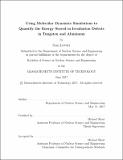| dc.contributor.advisor | Michael Short. | en_US |
| dc.contributor.author | Lowder, Sean | en_US |
| dc.contributor.other | Massachusetts Institute of Technology. Department of Nuclear Science and Engineering. | en_US |
| dc.date.accessioned | 2017-12-05T16:24:53Z | |
| dc.date.available | 2017-12-05T16:24:53Z | |
| dc.date.copyright | 2017 | en_US |
| dc.date.issued | 2017 | en_US |
| dc.identifier.uri | http://hdl.handle.net/1721.1/112369 | |
| dc.description | Thesis: S.B., Massachusetts Institute of Technology, Department of Nuclear Science and Engineering, 2017. | en_US |
| dc.description | This electronic version was submitted by the student author. The certified thesis is available in the Institute Archives and Special Collections. | en_US |
| dc.description | Cataloged from student-submitted PDF version of thesis. | en_US |
| dc.description | Includes bibliographical references (pages 49-52). | en_US |
| dc.description.abstract | Radiation damage in materials can create potentially catastrophic effects by causing failure in critical reactor components. In order to prevent such failures, it is imperative that this damage is understood and quantified. Currently, displacements-per-atom (DPA) is the most common form of expressing the amount of radiation a material has received. With its limitations on accurately expressing how much damage remains in a material post-irradiation, the DPA does not provide enough information about an exposed material to fully understand how it is has been compromised. One suggested replacement for the DPA is the Wigner stored energy, which is a measurement of the energy stored in radiation defects. To prepare for future experimental work, irradiation in tungsten and aluminum was simulated and analyzed for trends in defect energy. With increasing amounts of radiation exposure, it was found that the average energy associated with individual defects remains constant, but that defect clustering and dislocation forming increases. Simulations were then performed to mimic the process of calorimetry heating. These simulations showed how the defects annealed out with heating, and the results will be extrapolated to predict experimental results. If Wigner energy can be successfully measured and characterized, it can become a more universal and reliable way of expressing radiation damage, improving safety throughout the nuclear industry. | en_US |
| dc.description.statementofresponsibility | by Sean Lowder. | en_US |
| dc.format.extent | 65, 2 pages | en_US |
| dc.language.iso | eng | en_US |
| dc.publisher | Massachusetts Institute of Technology | en_US |
| dc.rights | MIT theses are protected by copyright. They may be viewed, downloaded, or printed from this source but further reproduction or distribution in any format is prohibited without written permission. | en_US |
| dc.rights.uri | http://dspace.mit.edu/handle/1721.1/7582 | en_US |
| dc.subject | Nuclear Science and Engineering. | en_US |
| dc.title | Using molecular dynamics simulations to quantify the energy stored in irradiation defects in tungsten and aluminum | en_US |
| dc.type | Thesis | en_US |
| dc.description.degree | S.B. | en_US |
| dc.contributor.department | Massachusetts Institute of Technology. Department of Nuclear Science and Engineering | |
| dc.identifier.oclc | 1011355070 | en_US |
